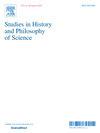The philosophical coming of age of science. Euler’s role in Cassirer’s early philosophy of space and time
IF 1.8
2区 哲学
Q1 HISTORY & PHILOSOPHY OF SCIENCE
引用次数: 0
Abstract
Cassirer’s early philosophy of space and time, overshadowed by his later work on relativity, has been scarcely explored in the literature. This paper aims to bridge this gap. It argues that understanding Cassirer’s point of view requires acknowledging the pivotal role he attributed to the work of Leonhard Euler in the philosophical ‘coming of age’ of modern science. Against the Leibniz-Berkeley philosophical plea for the relativity of all motion, Euler objected that if Newton’s absolute space and time did not exist, the principle of inertia would be come meaningless and with it a scientific theory of motion. According to Cassirer, Kant took a step beyond Euler by shifting the focus from the existence of space and time as ‘things’ to their function as necessary ‘conditions’ of the possibility of mechanics. In the nineteenth century, it became clear that Newton’s absolute space and time entail more structure than necessary. Nevertheless, according to Cassirer, the Euler-Kant insight still holds: a geometric structure serving as an inertial structure is the condicio sine qua non of a coherent theory of motion, including general relativity. This paper concludes that Cassirer came close to defending a sort of ‘inertial functionalism’ dressed in neo-Kantian garb.
科学的哲学时代。欧拉在卡西勒早期时空哲学中的作用
卡西勒早期的时空哲学被他后来的相对论著作所掩盖,文献中很少对其进行探讨。本文旨在弥补这一空白。本文认为,要理解卡西勒的观点,就必须承认他认为莱昂哈德-欧拉的工作在现代科学的哲学 "时代到来 "中所起的关键作用。欧拉反对莱布尼茨-伯克利关于所有运动的相对性的哲学主张,他反对说,如果牛顿的绝对空间和时间不存在,惯性原理就会失去意义,科学的运动理论也会随之失去意义。卡西勒认为,康德比欧拉更进一步,他把重点从空间和时间作为 "事物 "的存在转移到它们作为力学可能性的必要 "条件 "的功能上。在 19 世纪,牛顿的绝对空间和时间所包含的结构显然多于必要的结构。尽管如此,卡西勒认为欧拉-康德的见解仍然有效:作为惯性结构的几何结构是包括广义相对论在内的连贯运动理论的必要条件。本文的结论是,卡西勒接近于为一种披着新康德外衣的 "惯性功能主义 "辩护。
本文章由计算机程序翻译,如有差异,请以英文原文为准。
求助全文
约1分钟内获得全文
求助全文
来源期刊

Studies in History and Philosophy of Science
管理科学-科学史与科学哲学
CiteScore
2.50
自引率
10.00%
发文量
166
审稿时长
6.6 weeks
期刊介绍:
Studies in History and Philosophy of Science is devoted to the integrated study of the history, philosophy and sociology of the sciences. The editors encourage contributions both in the long-established areas of the history of the sciences and the philosophy of the sciences and in the topical areas of historiography of the sciences, the sciences in relation to gender, culture and society and the sciences in relation to arts. The Journal is international in scope and content and publishes papers from a wide range of countries and cultural traditions.
 求助内容:
求助内容: 应助结果提醒方式:
应助结果提醒方式:


